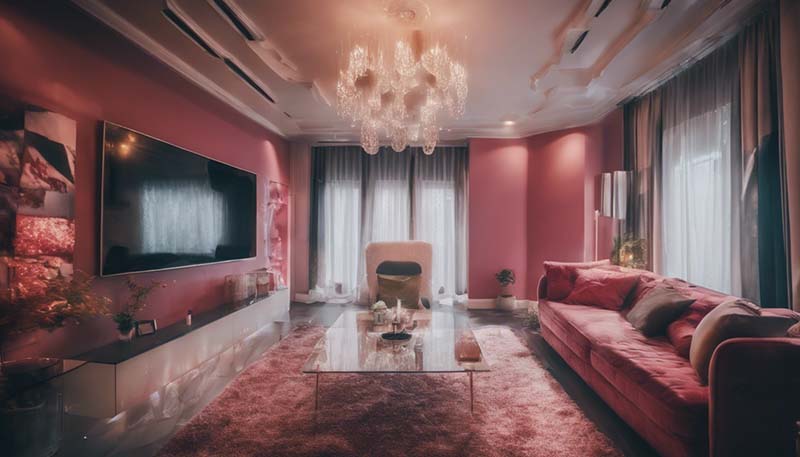The Power of Color in Interior Design
Introduction
Color is a powerful tool in interior design. It can evoke emotions, set the mood, and even influence our behavior. Understanding the impact of color is essential for creating a space that not only looks beautiful but also feels comfortable and inviting. In this article, we will explore the psychological effects of color, principles of color theory, and real-world examples of how color can transform a space.
Psychological Effects of Color
The perception of color is subjective and can vary from person to person. However, there are some general associations that many people share when it comes to color. For example, red is often associated with passion and energy, while blue is associated with calmness and stability. Let's delve deeper into the psychological effects of various colors:
Red
Red is a bold and attention-grabbing color. It is associated with passion, love, and excitement. In interior design, red can be used to create a warm and inviting atmosphere. However, it's important to use red sparingly as too much can be overwhelming and create a sense of anxiety.
Blue
Blue is a calming and serene color. It is often associated with the sky and the ocean, which can evoke feelings of tranquility. In interior design, blue can be used to create a peaceful and relaxing space. It's a popular choice for bedrooms and bathrooms.
Advertisement
Green
Green is the color of nature and is often associated with growth, renewal, and health. It can create a sense of balance and harmony in a space. Green is a versatile color that can be used in various settings, from living rooms to offices.
Yellow
Yellow is a cheerful and optimistic color. It is associated with happiness and warmth. In interior design, yellow can be used to add a touch of brightness and positivity to a space. However, it's important to be mindful of the shade of yellow used, as it can be quite bold and attention-grabbing.
Purple
Purple is a luxurious and sophisticated color. It is often associated with royalty and creativity. In interior design, purple can be used to create a sense of elegance and sophistication. However, it's important to use purple in moderation, as it can be quite overpowering.
White
White is a clean and neutral color. It is often associated with purity and simplicity. In interior design, white can be used to create a sense of openness and space. It's a popular choice for small rooms or areas where you want to create the illusion of a larger space.
Principles of Color Theory
Color theory is the study of how colors work together and how they affect each other. Understanding color theory can help you make more informed decisions when choosing colors for your interior design projects. Here are some key principles of color theory:
Color Wheel
The color wheel is a visual representation of colors arranged in a circle according to their relationships. It can be a useful tool for understanding color relationships and for creating harmonious color schemes.
Complementary Colors
Complementary colors are colors that are opposite each other on the color wheel. They create a strong contrast and can be used to create a vibrant and dynamic look in interior design.
Analogous Colors
Analogous colors are colors that are next to each other on the color wheel. They create a harmonious and cohesive look in interior design. This is a safe and easy way to create a pleasing color scheme.
Triadic Colors
Triadic colors are colors that are evenly spaced around the color wheel. They create a balanced and vibrant look in interior design. This can be a fun and adventurous way to create a color scheme.

Monochromatic Colors
Monochromatic colors are different shades of the same color. They create a cohesive and sophisticated look in interior design. This is a safe and easy way to create a color scheme that looks polished and put-together.
Real World Examples
Now that we understand the psychological effects of color and the principles of color theory, let's look at some real-world examples of how color can transform a space:
Living Room
In a living room, you might choose to use a warm and inviting color palette, such as a combination of reds, oranges, and yellows. This can create a cozy and welcoming atmosphere for guests.
Bedroom
In a bedroom, you might choose to use a calming and relaxing color palette, such as a combination of blues and greens. This can create a peaceful and restful space for sleep.
Kitchen
In a kitchen, you might choose to use a bright and cheerful color palette, such as a combination of yellows and greens. This can create an energetic and uplifting space for cooking and eating.
Bathroom
In a bathroom, you might choose to use a clean and neutral color palette, such as a combination of whites and grays. This can create a fresh and hygienic space for personal care.
Office
In an office, you might choose to use a professional and sophisticated color palette, such as a combination of blues and grays. This can create a focused and productive work environment.
Conclusion
Color is a powerful tool in interior design. By understanding the psychological effects of color and the principles of color theory, you can create spaces that not only look beautiful but also feel comfortable and inviting. Whether you're looking to create a warm and inviting living room, a peaceful and relaxing bedroom, or a focused and productive office, color can help you achieve your design goals.
 2024-02-14
2024-02-14 115 Comments
115 Comments